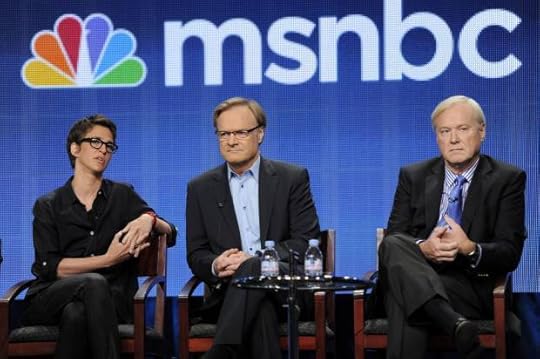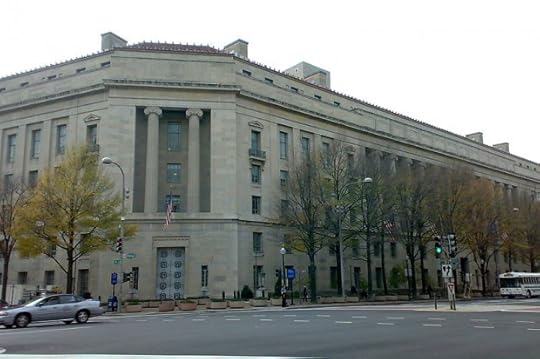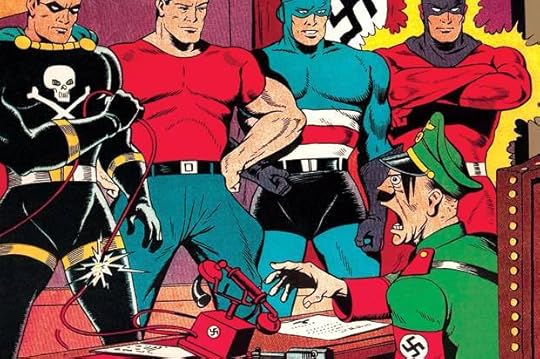Helen H. Moore's Blog, page 327
August 18, 2017
Salon Stage: Ron Pope performs songs from new album “Work”

Singer/songwriter Ron Pope stopped by Salon’s New York studio to play a set on the Salon Stage. He performed “Can’t Stay Here,” “Partner in Crime,” and “The Weather,” from his new album “Work,” which Pope describes as a project that “follows me from when I was 13 and a teacher told my mother that I’d probably end up in prison; I started messing around writing songs that year. It’s been mostly uphill ever since.” The baseball player turned independent artist also talked with Salon about the importance of music in his life and the freedom of owning his own label, Brooklyn Basement Records.
On what music means to him:
It’s my job, it’s my hobby, kind of all the parts of my life are involved in it. It’s a family business; I work with my wife. So music is a great deal of my life.
On how he stays motivated:
The biggest motivation that keeps me playing music is because they won’t let me play shortstop for the Mets, so I really had no choice.
On having a record label:
So my wife and I own a record label; it’s called Brooklyn Basement Records. It’s hard, it takes a lot of time, but we are lucky because we get to make music that we believe in and promote the music of new artists that we believe in, and nobody tells us what to do except for you guys. We get to take the music to the fans without a middleman. So having our own label is a great blessing.
Watch the exclusive video of Ron Pope playing “The Weather” off his album “Work”
After more executives flee Trump’s advisory board, White House claims he planned to disband the council anyway

It’s been a brutal week for President Donald Trump’s reputation for bringing dealmakers to the table.
After disbanding two private-sector advisory groups on Wednesday following numerous resignations, Trump has backed away from his plans to recruit corporate executives to advise him on infrastructure spending — during what the White House has branded Infrastructure Week.
Bloomberg News reported Thursday that the Advisory Council on Infrastructure, which was still being assembled when it was called off this week, would have brought together leaders from real estate, finance and other sectors to advise the president on infrastructure development.
On the campaign trail, Trump promised he would invest $1 trillion to fix the country’s roads, bridges, airports, power plants and other infrastructure, but in reality his plan entails doling out $200 billion in tax cuts to entice construction companies, utilities and investors to spend $800 billion on projects. Critics argue this would lead to boondoggles, more toll roads and other projects companies can monetize or exploit for tax purposes.
While Trump’s plans to elicit feedback from the private sector on infrastructure crumbled, members of the Commerce Department’s Digital Economy Board of Advisors (DEBA) began quitting Thursday.
Zoë Baird, the group’s co-chair and head of the Markle Foundation, confirmed to Vice News that she and other members of the board have submitted their resignations.
“It is the moral responsibility of our leaders to unite Americans by respecting the diversity and inclusion that enables our country to generate new opportunity and celebrate freedom,” Baird’s resignation letter obtained by Vice reads. “In order to preserve these cherished values, there must never be equivocation in denouncing hate, bigotry, violence and racism.”
The president faced a revolt from his private-sector advisors after he defended white-power nationalists that marched amid Nazi flags and chants in Charlottesville last weekend.
It was unclear who else has stepped down. According to a Commerce Department information sheet from December, board members include executives from Microsoft, Comcast, GE, the Ford Foundation and McKinsey & Company.
The DEBA was founded last year under Commerce Secretary Penny Pritzker, who was replaced by Wilbur Ross after Trump’s inauguration.On Wednesday, the president disbanded two CEO groups after several executives resigned over Trump comments equating neo-Nazis, KKK members and other hate groups to the counter-protesters.
Trump also faced a revolt from his creative council.
In an open letter in which the first letter of every paragraph spelled out “RESIST,” 16 out of 17 members of the President’s Committee on the Arts and the Humanities resigned on Friday and asked the president to do the same. Responding to the resignation, however, the White House claimed that Trump had planned to disband the group anyway.
MSNBC becomes most-watched cable news channel for first time ever

(Credit: AP Photo/Chris Pizzello)
While Democrats are not fans of having Donald Trump in the White House, his tenure as president has unquestionably been good for at least one left-leaning institution, MSNBC.
On Wednesday, ratings data revealed that the news and commentary channel was the most-watched network across all of basic cable for the first time in its history.
According to Nielsen Media Research, MSNBC was the top cable channel across the entire day and also in prime-time. Averaging 1.52 million total viewers from 6 a.m. to 2 a.m., the left-leaning network edged just past Fox News’ 1.5 million average. In primetime, MSNBC’s edge was greater as it averaged 2.61 million viewers compared to its right-leaning rival’s 2.4 million. CNN didn’t do as well among total viewers but among the key 25-54 demographic, it had the most viewers on Wednesday.
The ratings bump that MSNBC has seen fits a general media trend that news outlets that are perceived to be in opposition to the current White House occupant always experience stronger growth than media sources thought to be friendly to the president.
MSNBC viewers seem to be reconciling with the channel after some had raised concerns that its new corporate management had begun trying to steer it away from its liberal position. Fans of Lawrence O’Donnell were particularly concerned after network officials dragged out contract negotiations with him. He ultimately did sign a new deal.
Despite MSNBC’s Wednesday surge, however, Fox News has returned to the top of the cable news heap, when one looks at the longer-term data. For the week beginning Aug. 7, Fox News was the most-watched cable channel across the entire day as well as in primetime, according to Nielsen data released by AdWeek’s TVNewswer blog. In total day viewership, Fox News has been the top-ranked cable channel on a weekly basis for the past 32 weeks. It has been number one in primetime for 12 consecutive weeks.
There is no such thing as “white pride”

White nationalists, neo-Nazis and members of the "alt-right" exchange insults with counter-protesters as they attempt to guard the entrance to Emancipation Park (Credit: Getty/Chip Somodevilla)
To explain why the alt right/neo-Nazi/Klan/whatever notion of “protecting white identity” is so toxic, one analogy comes to mind. Back when I was in high school, there was a bully who enjoyed antagonizing with smaller students near the lockers. Usually he wouldn’t get physical, but on the occasions when he would, his victims faced an awful conundrum: refuse to fight back and thus get humiliated, as well as possibly seriously injured, or fight back and thereby face punishment from teachers who invariably insisted that “both sides” were to blame?
In the paradigm of modern American politics, the individuals who talk about protecting “white heritage” are the bullies. When the people who aren’t designated as white — African Americans, Hispanics, Jews, Muslims, and so on — mobilize to defend themselves, they do so in response to the bullying.
This doesn’t mean that the latter groups are justified in resorting to violence. It does mean, however, that there is a significant and ineradicable difference between their cause and that of the white supremacists, one that prohibits informed individuals of good will from conflating the two.
Indeed, the very term “white” exists for the sole purpose of creating an artificial class of so-called “superior” people in America’s social hierarchy. As I’ve explained in the past, historical scholars recognize that the construct of whiteness was invented to distinguish between the in-groups and out-groups in American social life. After the Civil War, it was reinforced by nationalists who wanted to unify America’s diverse regions behind a common cause (namely, the preservation of “white” culture).
This isn’t to say that there aren’t individual nationalities which are considered “white” today that don’t have their own heritage of which to be proud.
You can be rightly proud of being German or Irish or Polish or Italian or Greek. After all, those are nations which have their own rich histories and, when it comes to the United States, have developed their own subcultures with equally fascinating histories of their own.
Yet the fact that each of the groups I just listed was, at one time or another, also deemed “non-white” in this country proves the larger point about how the concept of whiteness is fundamentally toxic. While an American of German descent may be considered white today, this was not the case during World War I; while an American of Irish descent may be considered white today, this wasn’t the case when New York Gov. Al Smith and Massachusetts Sen. John Kennedy ran for president in 1928 and 1960.
In short, when white supremacists like the now-infamous Peter Cvjetanovic insist that they only marched in Charlottesville to argue that “white European culture has a right to be here just like every other culture,” they are using code language to cover up their true agenda. Similarly, when President Donald Trump argues that the people protesting against white supremacism are morally equivalent to those protesting in favor of it, he is at best ignorant of the history behind “whiteness” and at worst disingenuously trying to conceal his actual sinister belief system.
Every man, woman and child has a right to be proud of their heritage, but no one has a right to oppress others based on that pride. Yet anyone who advocates in favor of white identity is doing precisely that, and as such must be met with the condemnation of decent human beings everywhere.
Forward to yesteryear! Get ready for the new Gilded Age

(Credit: Reuters/Rick Wilking)
As Democrats debate whether they should adapt some slogan snappier than “A Better Deal” to woo voters in next year’s elections, I offer one to the Republicans, based on recent legislative announcements, that should cleverly appeal to both forward-looking and conservative thinkers alike, to wit, FORWARD TO YESTERYEAR!
Alas, it’s no laughing matter.
On Aug. 2, President Trump announced two new initiatives to advance his campaign to “make America great again” without any clear message of exactly what he means. But if you look closely, they go a long way toward clarifying a couple of his intentions.
One was the repeal and replacement of the Immigration Act of 1965, which itself replaced earlier laws of the 1920s. Those had set racial and ethnic quotas to limit the entry of so-called racially “inferior” post-Civil War immigrants from Southern and Eastern Europe. They also banned immigration from Asian countries entirely, completing a process begun with the Chinese Exclusion Act of 1882 on the grounds that both these groups brought crime and disease in their wake and undercut the wages of American workers.
The 1965 legislation abandoned such restrictions entirely and replaced them with a system based on uniting families and encouraging immigrants with special artistic or scientific talent.
Trump’s new proposal would be “merit-based” and award points to those with literacy in English, advanced education, lucrative job offers waiting or, of course, existing capital. What’s more, the overall numbers of immigrants admitted would be slashed almost in half. The huddled masses would stay huddled in their refugee camps and slums. Back we would go to the “safety” of 1925.
Trump’s other new initiative is the creation of a special unit in the Department of Justice to investigate “anti-white” discrimination. This is a tactic to pump new life into the long campaign by conservatives to undo desegregation measures mandated in the civil rights laws of the ‘60s, which guarantee equal opportunities in hiring and college admissions to African-Americans.
Coupled with the ongoing assault on voting rights that primarily would disenfranchise low-income and especially black voters on the phony grounds of preventing nonexistent election frauds, they make it plain that the reel of Trumpian “reforms” always spins backward.
Consider the evidence. First came the attack on the programs of the Great Society, including such programs as Medicare and Medicaid, as well as deep cuts in programs for early education, nutrition, mass transportation and urban renewal. Creation of some agencies now under attack, like the EPA and OSHA were even signed by Richard Nixon, however reluctantly, after LBJ had left office. Those two agencies will be gelded by leadership dedicated to their destruction, the goal of Trump’s alt-brain, Steve Bannon. The concept seems to be to cleanse the nation of any trace of progressive policy injected into society since LBJ left office. Away with them, then tackle their origins which go back to Franklin Roosevelt’s New Deal reforms. We will once again enjoy America when it was truly great, in 1929 just before the speculations of the rich plunged us into the Great Depression.
I remember the passion of reactionaries to repeal the New Deal, because I was living through the 1930s as a teenager. Efforts to create what we now call the liberal welfare state were despised and assailed by the “economic royalists” who hated FDR and whose hatred he “welcomed.” Small wonder. To fight the Depression and the power of Wall Street to bring on another, the New Deal dissolved monopolies, regulated banks and the stock market to curb runaway speculation, enabled workers to organize in unions, created beautiful and useful public works built by unemployed Americans earning public salaries, increased public housing, restored drought-stricken areas of the public domain with conservation measures carried out by a peaceful “army” of jobless youths, and brought electricity to rural America, among other successes.
Today, the heirs of those same economic royalists are back in the saddle, with a program that is nothing less than the erasure not only of the “Roosevelt Revolution” but of the entire list of achievements of the Progressive movement dating back to the 1880s. Their primary weapon is the revival of a 1944 “Bible” of government-hating libertarians, Friedrich Hayek’s “The Road to Serfdom.” No bad idea ever really dies, and with Trump’s ascendency and Republican control of all three branches of government, this one got a robust new lease on life.
Hayek’s basic argument was that government intervention in the workings of the free market meant giving power to officials to regulate economic behavior, such as telling a businessman at what price he could sell his product, could lead to a radical expansion of authority eventually reaching every corner of life — in essence to wipe out freedom entirely and to slide down the slippery slope to Fascism. Though Hayek did allow for the government to step in on occasion to curb a visible abuse, his more ardent followers spent most of their time and energy emphasizing the threat to liberty in abandoning market principles.
It was no coincidence that at the beginning of the Reagan era in 1980 Milton and Rose Friedman’s book “Free to Choose” became a best-seller and the subject of a television series — on PBS, of all places. Hayek died in 1992. In 2008 Jonah Goldberg published “Liberal Fascism,” which argues that progressives had created an “administrative state” run by an elite of liberal economists who practiced “social engineering,” which, among other indignities, contemptuously trampled on the natural and God-given rights of intelligent workers to “freely” contract with employers for jobs that in reality paid less than a living wage in return for exhausting, dehumanizing hours of work. It’s a position that gives new meaning and power to the word “reactionary.”
Hayek’s book enjoyed a new and enlarged audience in 2010, when Glenn Beck made it the subject of a set of TV interviews. A recent request I made for “articles citing Friedrich Hayek appearing in 2017″ yielded more than 700 articles. I have just recently read the 2016 “Illiberal Reformers” by Thomas Leonard, which contends that “modern liberalism permanently discarded economic liberties” and likewise got around to “trampling on individual rights to person, to free expression, to marriage and to reproduction.”
Whether Trump truly believes in this exaggerated “government is the enemy” doctrine can’t be said for sure. The man doesn’t appear to think; he only reacts to challenges to his inflated opinion of himself. But he does not seem uncomfortable about returning us to a pre-progressive era in which unions struggled to be born, bloody strikes were crushed by troops, small children worked long hours in dangerous trades, the Senate was a millionaire’s club elected by corrupt state legislatures instead of directly by the vote of the people, consumers risked being poisoned by patent medicines or tainted foodstuffs, and prices were rigged.
Trump’s race to consign every evidence of past progress to the “memory hole” of history, where they can be forgotten and replaced with state lies and alternate reality as defined by the maximum leader, is poison directed at the heart of democracy. It shouts for resistance in every medium and in every form — now. There may not be a second chance.
So, historians, to the barricades!
This post is part of a three-part series in which historians examine Donald Trump’s plans to “Make America Great Again” and consider what point in American history President Trump was thinking about when he said “again.” Clearly, different voters heard different things. Now that we’re more than six months into his presidency, these historians review his legislation and policies and explain where that might place us in the past. Read other postsin the series.
Why is the Justice Department targeting an online audience of over 1 million anarchists?

The US Department of Justice, Washington D.C. (Credit: Wikimedia)
The war on dissent is expanding exponentially.
In the first week of the Trump presidency, White House adviser Steve Bannon said the “media should shut up.”
Last month, Jeff Sessions threatened to haul journalists before grand juries and force them to testify about their confidential sources or face jail time.
Last week, the Justice Department signaled its intention to go after 1.3 million visitors to an anti-Trump website. The Department of Justice served a search warrant for the electronic records of DreamHost, a Los Angeles-based firm that hosts the website of #DisruptJ20.org, a “direct action” collective that protested Trump’s inauguration, sometimes violently.
DreamHost is fighting the warrant, saying the information “could be used to identify any individuals who used this site to exercise and express political speech protected under the Constitution’s First Amendment. That should be enough to set alarm bells off in anyone’s mind.”
The Electronic Frontier Foundation has joined the fight, and the ACLU says its privacy lawyers are “assessing the situation.”
In the search warrant, signed July 12 by John Borchert, deputy chief of the Felony Major Crimes Trial Section of the Justice Department, says the government seeks “evidence about individuals who participated, planned, organized or incited the January 20 riot.”
The government, he declared, wants “all information that might identify the subscribers . . . including names, addresses, telephone numbers and other identifiers, email addresses, business information . . . and source of payment for services including any credit card or bank account information.”
DreamHost is obeying the law requiring the disclosure of confidential information if it is relevant to an ongoing criminal investigation. The court filings in the case make clear that the firm shared information about disruptJ20.org within a week of Trump’s inauguration, including the registrant’s name, address and payment information.
In April, some 200 people were charged in connection with inauguration protests that resulted in the vandalism of a car and breaking of windows.
But when DreamHost received the far more sweeping request in July demanding information about all visitors to the group’s website, the company balked. The firm’s attorneys asked Borchert for a meeting to address their concerns. Borchert responded by asking DreamHost to begin “rolling production” of records immediately.
The unwillingness of the Justice Department to narrow the request is a tip-off that the government is not just seeking information about people who have broken the law. Rather, it is searching for information about people who have notbroken any law.
Another tip-off: the government’s search warrant does not explain what would happen to the information the government obtained that is not subject to “seizure” because it is not evidence of a crime.
“In essence, the search warrant not only aims to identify the political dissidents of the current administration, but attempts to identify and understand what content each of these dissidents viewed on the website,” stated Raymond Aghaian, attorney for DreamHost, in an August 11 motion seeking to quash the warrant.
“No plausible explanation exists for a search warrant of this breadth, other than to cast a digital dragnet as broadly as possible,” writes Mark Rumold of the Electronic Frontier Foundation. He continues:
But the Fourth Amendment was designed to prohibit fishing expeditions like this. Those concerns are especially relevant here, where DOJ is investigating a website that served as a hub for the planning and exercise of First Amendment-protected activities.
Richard Painter, chief White House ethics lawyer under President Bush, called the move an “abuse of power.”
This is abuse of power. DOJ is not there to investigate the President’s political opponentshttps://t.co/DOvCc4JFPR
— Richard W. Painter (@RWPUSA) August 15, 2017
A Washington federal court judge will hear arguments in the case this Friday.
The seeds of the alt-right, America’s emergent right-wing populist movement

Steve Bannon (Credit: Getty/Mandel Ngan/Salon)
Over the past year, far-right activists — which some have labeled the “alt-right” — have gone from being an obscure, largely online subculture to a player at the very center of American politics.
On August 12, an amalgamation of far-right activist groups, ranging from Vanguard America to Identity Evropa, convened in Charlottesville, Virginia for a “Unite the Right” rally. The event took a tragic turn tragic when a 20-year-old white supremacist from Ohio plowed into a crowd of counter-demonstrators, killing one and injuring 19.
Long relegated to the cultural and political fringe, alt-right activists were among the most enthusiastic supporters of Donald Trump. Former Breitbart.com executive Steve Bannon — who declared the website “the platform for the alt-right” — is the President’s chief political strategist.
I’ve spent years extensively researching the American far right, and the movement seems more energized than ever. To its critics, the alt-right is just a code term for white nationalism, a much-maligned ideology associated with neo-Nazis and Klansmen. The movement, however, is more nuanced, encompassing a much broader spectrum of right-wing activists and intellectuals.
How did the movement gain traction in recent years? And has the alt-right already changed America’s political landscape?
Mainstreaming a movement
The alt-right includes white nationalists, but it also includes those who believe in libertarianism, men’s rights, cultural conservatism and populism.
Nonetheless, its origins can be traced to various American white nationalist movements that have endured for decades. These groups have historically been highly marginalized, with virtually no influence on the mainstream culture and certainly not over public policy. Some of the most radical elements have long advocated a revolutionary program.
Groups such as the Aryan Nations, White Aryan Resistance, the National Alliance and the World Church of the Creator have preached racial revolution against ZOG, or the “Zionist Occupation Government.” Many were inspired by the late William L. Pierce’s “Turner Diaries,” a novel about a race war that consumes America. (Timothy McVeigh, who carried out the 1995 Oklahoma City bombing, had pages from the book in his possession when he was captured.)
But these exhortations didn’t resonate with most people. What’s more, after 9/11, many of the revolutionary right’s leading representatives were prosecuted under new anti-terrorism statutes and sent to prison. By the mid-2000s, the far right appeared to have reached its nadir.
Into this void stepped Richard Spencer and a new group of far-right intellectuals.
In 2008, conservative political philosopher Paul Gottfried was the first to use the term “alternative right,” describing it as a dissident far-right ideology that rejected mainstream conservatism. (Gottfried had previously coined the term “paleoconservative” in an effort to distance himself and like-minded intellectuals from neoconservatives, who had become the dominant force in the Republican Party.)
William Regnery II — a wealthy and reclusive publisher — founded the National Policy Institute as a white nationalist think tank. A young and rising star of the far right, Spencer assumed leadership in 2011. A year earlier, he launched the website “Alternative Right” and became recognized as one of the most important, expressive leaders of the alt-right movement.
Around this time, Spencer popularized the term “cuckservative,” which has gained currency in the alt-right vernacular. In essence, a cuckservative is a conservative sellout who is first and foremost concerned about abstract principles such as the U.S. Constitution, free market economics and individual liberty.
The alt-right, on the other hand, is more concerned about concepts such as nation, race, civilization and culture. Spencer has worked hard to rebrand white nationalism as a legitimate political movement. Explicitly rejecting the notion of racial supremacy, Spencer calls for the creation of separate, racially exclusive homelands for white people.
Different factions
The primary issue for American white nationalists is immigration. They claim that high fertility rates for third-world immigrants and low fertility rates for white women will — if left unchecked — threaten the very existence of whites as a distinct race.
But even on the issue of demographic displacement, there’s disagreement in the white nationalist movement. The more genteel representatives of the white nationalism argue that these trends developed over time because whites have lost the temerity necessary to defend their racial group interests.
By contrast, the more conspiratorial segment of the movement implicates a deliberate Jewish-led plot to reduce whites to minority status. By doing so, Jews would render their historically most formidable “enemy” weak and minuscule — just another minority among many.
Emblematic of the latter view is Kevin MacDonald, a former psychology professor at the California State University at Long Beach. In a trilogy of books released in the mid- to late 1990s, he advanced an evolutionary theory to explain both Jewish and antisemitic collective behavior.
According to MacDonald, antisemitism emerged not so much out of perceived fantasies of Jewish malfeasance but because of what he argued were genuine conflicts of interests between Jews and Gentiles. He’s claimed that Jewish intellectuals, activists and leaders have sought to fragment Gentile societies along the lines of race, ethnicity and gender. Over the past decade and a half, his research has been circulated and celebrated in white nationalist online forums.
A growing media and internet presence
Cyberspace became one area where white nationalists could exercise some limited influence on the broader culture. The subversive, underground edges of the internet — which include forums like 4chan and 8chan — have allowed young white nationalists to anonymously share and post comments and images. Even on mainstream news sites such as USA Today, The Washington Post and The New York Times, white nationalists can troll the comments sections.
More important, new media outlets emerged online that began to challenge their mainstream competitors: Drudge Report, Infowars and, most notably, Breitbart News.
Founded by Andrew Breitbart in 2007, Breitbart News has sought to be a conservative outlet that influences both politics and culture. For Breitbart, conservatives didn’t adequately prioritize winning the culture wars — conceding on issues like immigration, multiculturalism and political correctness — which ultimately enabled the political left to dominate the public discourse on these topics.
As he noted in 2011, “politics really is downstream from culture.”
The candidacy of Donald Trump enabled a disparate collection of groups — which included white nationalists — to coalesce around one candidate. But given the movement’s ideological diversity, it would be a serious mischaracterization to label the alt-right as exclusively white nationalist.
Yes, Breitbart News has become popular with white nationalists. But the site has also unapologetically backed Israel. Since its inception, Jews — including Andrew Breitbart, Larry Solov, Alexander Marlow, Joel Pollak, Ben Shapiro and Milo Yiannopoulos — have held leading positions in the organization.
Furthermore, the issues that animate the movement — consternation over immigration, national economic decline and political correctness — existed long before Trump announced his candidacy. As political scientist Francis Fukuyama opined, the real question is not why this brand of populism emerged in 2016, but why it took so long to manifest.
Mobilized for the future?
The success of the Trump campaign demonstrated the potential influence of the alt-right in the coming years. At first blush, Trump’s victory in the Electoral College seems substantial. But his margin of victory in several key states was quite slim. For that reason, support from every quarter he received — including the alt-right — was vitally important.
Anecdotal evidence suggests that they were among his most avid foot soldiers in getting out the vote in both the primaries and general election. Moreover, the Trump campaign provided the opportunity for members of this movement to meet face to face.
Shortly after the election, Richard Spencer said that Trump’s victory was “the first step, the first stage towards identity politics for white people.” During the “Unite the Right” rally in Charlottesville, Ku Klux Klan leader David Duke said, “We are determined to take our country back. We are going to fulfill the promises of Donald Trump.”
But if Trump fails to deliver on his most emphatic campaign promises — such as building the wall — the alt-right might become disillusioned with him, just like the progressives who chastised Barack Obama for continuing to prosecute wars in the Middle East.
Unlike old-school white nationalist movements, the alt-right has endeavored to create a self-sustaining counterculture, which includes a distinct vernacular, memes, symbols and a number of blogs and alternative media outlets.
Now that it has been mobilized, the alt-right is gaining a firmer foothold in American politics.
George Michael, Professor of Criminal Justice, Westfield State University

August 17, 2017
Doctors warm to single-payer health care

(Credit: Getty/Cecilie Arcurs)
Single-payer health care is still a controversial idea in the U.S., but a majority of physicians are moving to support it, a new survey finds.
Fifty-six percent of doctors registered either strong support or were somewhat supportive of a single-payer health system, according to the survey by Merritt Hawkins, a physician recruitment firm. In its 2008 survey, opinions ran the opposite way — 58 percent opposed single-payer. What’s changed?
Red tape, doctors tell Merritt Hawkins. Phillip Miller, the firm’s vice president of communications, said that in the thousands of conversations its employees have with doctors each year, physicians often say they are tired of dealing with billing and paperwork, which takes time away from patients.
“Physicians long for the relative clarity and simplicity of single-payer. In their minds, it would create less distractions, taking care of patients — not reimbursement,” Miller said.
In a single-payer system, a public entity, such as the government, would pay all the medical bills for a certain population, rather than insurance companies doing that work.
A long-term trend away from physicians owning their practices may be another reason that single-payer is winning some over. Last year was the first in which fewer than half of practicing physicians owned their practice — 47.1 percent — according to the American Medical Association’s surveys in 2012, 2014 and 2016. Many doctors are today employed by hospitals or health care institutions, rather than working for themselves in traditional solo or small-group private practices. Those doctors might be less invested in who pays the invoices, Miller said.
There’s also a growing sense of inevitability, Miller said, as more doctors assume single-payer is on the horizon.
“I would say there is a sense of frustration, a sense of maybe resignation that we’re moving in that direction, let’s go there and get it over with,” he said.
Merritt Hawkins emailed its survey Aug. 3 and received responses from 1,003 doctors. The margin of sampling error is plus or minus 3.1 percentage points.
The Affordable Care Act established the principle that everyone deserves health coverage, said Shawn Martin, senior vice president for advocacy at the American Academy of Family Physicians. Inside the medical profession, the conversation has changed to how best to provide universal coverage, he said.
“That’s the debate we’re moving into, that’s why you’re seeing a renewed interest in single-payer,” Martin said.
Dr. Steven Schroeder, who chaired a national commission in 2013 that studied how physicians are paid, said the attitude of medical students is also shifting.
Schroeder has taught medicine at the University of California-San Francisco Medical Center since 1971 and has noticed students’ increasing support for a single-payer system, an attitude they likely carry into their professional careers.
“Most of the medical students here don’t understand why the rest of the country doesn’t support it,” said Schroeder.
The Merritt Hawkins’ findings follow two similar surveys this year.
In February, a LinkedIn survey of 500 doctors found that 48 percent supported a “Medicare for all” type of system, and 32 percent opposed the idea.
The second, released by the Chicago Medical Society in June, reported that 56 percent of doctors in that area picked single-payer as the “best care to the greatest number of people.” More than 1,000 doctors were surveyed.
Since June 2016, more than 2,500 doctors have endorsed a proposal published in the American Journal of Public Health calling for a single-payer to replace the Affordable Care Act. The plan was drafted by the Physicians for a National Health Program (PNHP), which says it represents 21,600 doctors, medical students and health professionals who support single-payer.
Clare Fauke, a communications specialist for the organization, said the group added 1,065 members in the past year and membership is now the highest since PNHP began in 1987.
The sound of inclusion: Why teachers’ words matter

(Credit: iStockphoto/skynesher)
There isn’t just one way to sound like a scientist, or to sound like a scholar. Scientists and scholars come from a wide variety of backgrounds and speak in different ways, in different accents, dialects and languages.
In classrooms across the U.S., students do too. No student (or teacher) leaves their language patterns at the door when they enter a classroom – even classes like math and science, where language is often seen as secondary.
For the past decade, as professors who study the role of language and culture in education, we’ve been working to help educators understand these dynamics across all subject areas. As the U.S. student population continues to rapidly diversify along cultural and linguistic lines, the demographics of the teacher population remain stable at roughly 82 percent white and predominantly female.
How can educators make sure that teaching and learning in their diverse classrooms is effective and equitable?
Understanding how and why culture and communication matter in all areas of education — from science to the humanities — is a critical starting point.
When students don’t sound the same
Students who speak differently can face a number of challenges at school.
Studies have found that at all levels of education, instructors often favor students who sound like themselves and can be biased against those who don’t. Educators might form negative assumptions about a student’s intelligence and ability based simply on how he or she talks, which can result in lowered expectations, stereotyping and discrimination. Teachers sometimes also send messages, whether consciously or unconsciously, that a student’s language is wrong, dumb or out of place at school.
For instance, consider what one mother told us about an interaction she witnessed in her son’s first grade classroom. One of the boys, who is African-American, was playing a game and realized he didn’t have the materials he needed. He raised his hand and said to the teacher, “I don’t got no dice.” His teacher immediately responded, “Joshua, we speak English in this class!” The mother was appalled and felt that this experience could discourage Joshua from speaking up at school.
When students absorb and internalize such messages, they can experience what linguist William Labov called “linguistic insecurity” – feelings of anxiety and apprehension that can take root even at an early age.
These negative experiences with language and communication in the classroom can have a direct impact on students’ academic achievement. As early as kindergarten, students who come to school speaking in similar ways as their teachers are more likely to get ahead, whereas those who speak differently are more likely to fall behind. These language-based educational inequalities disproportionately affect African-American students and other students of color, English language learners and students who come from a social class or regional background that is different from that of their teacher.
As Joshua’s mother said to us, “There must be a better way to respond.”
Putting language into the equation
For the past decade, we’ve worked not only as scholars but as teacher trainers as well. Some of our professional development workshops are geared toward a particular group of educators: those who teach K-12 science, technology, engineering and mathematics, also known as STEM.
In 2011, we began a three-year study with 60 K-12 STEM educators in Maryland and Virginia to explore how language can affect teaching and learning for STEM students, particularly for African-American youth. The teachers were eager to learn, but also to share experiences from their own classroom teaching about the role that language can play in STEM — whether it’s answering a word problem in math, reading an engineering text or writing a lab report.
One of the biggest challenges is that, in STEM, word problems, questions, texts and directions often contain unfamiliar terms, both technical and nontechnical. In fact, nontechnical words can often be as problematic as the more specialist terms of science. “It’s kind of like learning a language twice,” a geometry teacher said, because “the vocabulary can be so intense.”
And it’s not just vocabulary that matters; everyday classroom communication plays an important role, too. “We all use language,” one STEM teacher recognized, “whether it’s in the directions we give or the handouts we use.”
What can we do right now?
How can teachers make an immediate difference in their classes? For educators who want to know how to take this information and apply it directly to their teaching, there are relevant, accessible materials.
The Language and Life Project, out of North Carolina State University, hosts a number of videos and podcasts about language.
In addition to a comprehensive website, we created a series of webinars about the role of language in teaching and learning across the disciplines, as well as a podcast in which educators themselves describe how this information positively impacted their teaching and their relationships with students.
These materials can help teachers learn how to respond to students who speak differently, avoid cultural and linguistic bias on tests and design culturally supportive curricula.
In the course of our research, we also created a free iOS app (“Valuable Voices”) for educators. The app provides a year of monthly classroom-ready exercises and activities, adaptable for elementary through high school students. One exercise introduces students to the concept of language change by analyzing the linguistic innovations of William Shakespeare. Another activity invites students to explore “linguistic landscapes,” or the language found in public places and spaces around them.
Language matters
Good teaching relies on effective communication, whether it’s in English class, biology class or any subject in between. The words that teachers and students use, their meanings and their intentions are central to classroom interactions and dynamics. Ensuring that students, peers and teachers from diverse backgrounds understand and communicate respectfully with each other is often just as important as helping students understand the material in their textbooks.
Language matters – not just for fostering mutual respect, but for making sure that every student has an equal opportunity to succeed.
As one high school algebra teacher who participated in our study pointed out:
“Spending time showing students how their language is respected, and allowing them to have the skills to analyze different ways of speaking and writing, creates a classroom where we celebrate what we can each bring to our learning environment.”
 Simply put, she said, “It’s worth our time.”
Simply put, she said, “It’s worth our time.”
Christine Mallinson, Associate Professor of Language, Literacy, and Culture, University of Maryland, Baltimore County and Anne Charity Hudley, Associate Professor of Education, English, and Linguistics, College of William & Mary
A collection of anti-Nazi comic book covers from the 1940s is one of the most relevant books of the year

"Take That, Adolf!" (Credit: Fantagraphics Books)
One of the most famous covers in comic book history is Captain America #1 — featuring Cap punching Hitler in the face, months before we entered World War II. Cap co-creators Joe Simon and Jack Kirby (who would have turned 100 this month) would both go on to serve in that war.
But Kirby and Simon’s classic cover was only the tip of the anti-fascism-berg. Though comics have long been known as a vehicle for escapism, during the 1940s dozens of creators and companies produced a slew of covers and stories aimed right at the head of Hitler and the other Axis Powers. Mark Fertig’s gorgeous book “Take That, Adolf!: The Fighting Comic Books Of The Second World War,” released in April, documents and analyzes over 500 of these covers. Given the infuriating events in and after Charlottesville, these images are no longer just a historical treasury. Anyone looking for inspiration in the fight against white hate can find plenty in these exuberant and defiant images.
Not many people would think of Hitler as a comic book villain, but as Fertig found, Hitler appeared on more covers than perennial villains the Red Skull or the Joker in the Golden Age of comics. Martin Goodman — a Jewish son of Russian immigrants and the publisher of Timely Comics, which would eventually become Marvel — was the prime mover behind the genre collected in “Take That, Adolf.” Goodman began, somewhat tentatively, with the December 1939 cover of Marvel Mystery Comics #2, featuring the Angel in battle with some fighter planes: their logos not-quite swastikas, but the meaning is clear.
Fertig describes how the comic book industry’s response to the Nazis and other Axis Powers grew from tentative (a 1940 issue of Daring Mystery Comics changed “Hitler” to “Hiller”) to overwhelming, with just about every character getting in on the fight. Following Timely’s lead, other publishers began launching war-centric covers, and soon just about every character was fighting Nazis or pushing war bonds, including Captain Marvel, Green Lantern, Donald Duck, the Justice Society, Superman, Batman and Robin, Bugs Bunny, Joe Palooka, and even Little Orphan Annie, in addition to lesser known characters such as the Blue Beetle, Captain Midnight, Super Rabbit, and Catman, who is strangling Hitler in a particularly vivid cover from 1943.
It’s no accident that comics became a powerful source of anti-Nazi propaganda: the heavily Jewish industry had more to fear than most from Hitler. In an email interview, Fertig spoke of the bravery and creativity of Jewish creators who not only took on the Nazis but transformed a fledgling industry into something significant. Fertig praised “all the Jewish kids . . . who were there at the beginning and transformed comic books from a momentary curiosity into a lasting cultural phenomenon. Will Eisner, Simon and Kirby, [Jerry] Siegel and [Joe] Shuster, Stan Lee, Gil Kane, Charles Biro, Bill Finger, Charlie Gaines, the list goes on and on . . . We were very much an isolationist country in those days; it took real guts to take on Hitler and the Nazis with America still so many months away from entering the war. If the writers, artists, editors, and publishers hadn’t been predominantly Jewish, eager to create heroes who could kick the stuffing out of arch-villain Hitler, comic books might have remained the province of funny animals, jungle queens, and he-man adventurers, and consequently faded away.”
Fertig records many delicious details that might surprise today’s comic fans: including the fact that Captain America was not the first patriotic superhero. He was preceded by the suspiciously similar Shield 14 months earlier. Post Captain America, the genre of patriotic heroes exploded, including V-Man, Captain Battle, Man of War, the Lone Warrior, the American Crusader, Major Victory, Mr. Liberty, Mr. Justice, Yankee Doodle Jones, plus the Flag and Flag-Man. Refreshingly, the fad of patriotic heroes wasn’t all fellas. Miss Victory, Miss America, Pat Patriot and the incredibly named War Nurse, who should have her own movie franchise. Wonder Woman was a patriotic hero too: the female Captain America in many ways.
But of course the forties weren’t some egalitarian paradise, and Fertig doesn’t gloss over the racism of the era, which he refers to as “overwhelming.” Some of these covers — in particular, ones depicting the Japanese as human-rat hybrids — are exactly what you would expect from a society that had internment camps. Fertig says, “Early on I realized that there was no honest or ethical way I could do this book without confronting the issue head on. The ugly irony of the World War II period comic book business is that while covers and stories preached to readers about the flaws inherent in the Nazi’s racist ideology, writers and artists continued to present African Americans as bumbling comic relief and Asians as fanged yellow monsters.” He adds, “I wish that the industry had done more to challenge the crude stereotypes — and there are a few isolated moments where creators tried — but in the end, we have to accept that wartime comic books did more to reinforce a racist zeitgeist than upend it.”
The racism of some covers is as disgusting as the anti-Nazism of others is inspiring: both aspects are, to put it mildly, relevant in 2017. Fertig didn’t intend this book to be anything more than a historical document and “celebration of art,” but it’s become something more in a country where white-power rallies are apparently becoming a regular thing.
We need all the anti-Nazi inspiration we can get, and Fertig thinks we can find plenty in these covers and the people behind them: “In late 1940, when Joe Simon and Jack Kirby created the first Captain America comic — the one with Cap landing a haymaker square on Hitler’s jaw — the hate mail and death threats rolled in. Members of the pro-Nazi German American Bund began to shadow the pair around Manhattan; eventually the police had to be called in. Those young idiots in Charlottesville with their tiki torches are nothing new in this country; people like them have always been with us. But back in 1941, when the Japanese invaded Pearl Harbor and America was drawn fully into the war, the nation galvanized around defeating Hitler and his cronies. The would-be Nazis in our midst crawled back under their rocks, but they didn’t vanish. This administration has given the bigots among us tacit approval to crawl out and spew their hate. It’s up to the rest of us to do something about it.”




